Mariscal Sucre International Airport
| Mariscal Sucre International Airport Aeropuerto Internacional Mariscal Sucre | |||||||||||
|---|---|---|---|---|---|---|---|---|---|---|---|
|
| |||||||||||
| Summary | |||||||||||
| Airport type | Public | ||||||||||
| Operator | Quiport,[1] CORPAQ[2] | ||||||||||
| Serves | Quito, Pichincha, Ecuador | ||||||||||
| Location | Tababela, Quito Canton | ||||||||||
| Hub for | |||||||||||
| Focus city for | |||||||||||
| Elevation AMSL | 2,400 m / 7,874 ft | ||||||||||
| Coordinates | 0°06′48″S 78°21′31″W / 0.1133°S 78.3586°WCoordinates: 0°06′48″S 78°21′31″W / 0.1133°S 78.3586°W | ||||||||||
| Website |
www www | ||||||||||
| Map | |||||||||||
 UIO Location of airport in Ecuador | |||||||||||
| Runways | |||||||||||
| |||||||||||
Mariscal Sucre International Airport[3] (Spanish: Aeropuerto Internacional Mariscal Sucre) (IATA: UIO, ICAO: SEQM) is the busiest airport in Ecuador and one of the busiest airports in South America. It is located in the Tababela parish, about 18 kilometres (11 mi)[4] east of Quito and serves as the largest hub of TAME, the flag carrier of Ecuador, with an average of over 220 weekly flights. It opened in February 2013 and replaced the old Mariscal Sucre International Airport.[5]
Location
The new Quito International Airport is located on the Oyambaro plain near the town of Tababela, about 18 kilometers (11 mi) east of Quito, Ecuador. The location was chosen in order to expand the capacity of the city's airport. The old airport posed enormous risks due to its location in a residential area of the city's northern sector.
History
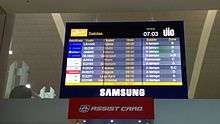
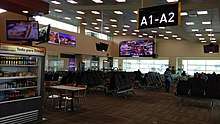
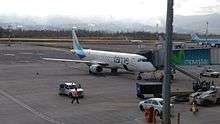
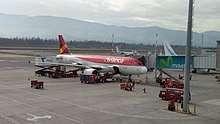
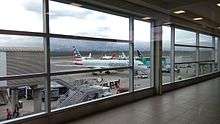
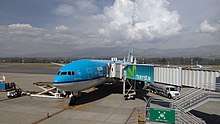
Construction began in 2006.[6] A re-negotiation of the financing contract for the airport was signed on 9 August 2010.[7]
At about 6:19 a.m. on July 2, 2012, an American Airlines Boeing 757 landed at the new airport with about 100 passengers on board. The flight was used to obtain the operating certificate for track tests. It also allowed testing of the performance of the electronics mounted for handling and transporting luggage and check-in counters for passengers and baggage. The aircraft departed from the existing Mariscal Sucre International Airport with Quito's Mayor, Augusto Barrera, local authorities, aviation staff, and the media to pre-test boarding procedures at 5:30 a.m., later taking off at about 6:10 a.m. After a 9-minute flight, the flight landed at the new Airport. After landing and subsequent taxiing through taxiway 1 of the new airport, the airplane was greeted with a water cannon salute from two fire trucks.
Subsequently, visitors toured the facilities of the passenger terminal building and the north and south ends of the runway. After the tour, Mayor Barrera and authorities gave a press conference. There, the Mayor also stated that the airport would be ready at its inauguration, as well as enhancements to the E-35, and Interoceanic highways. "This is a day of joy and optimism for the city. At this point all you get joining goodwill," the official said adding that the social energy that the city should serve to build and make things.
Mayor Barrera also stated that this airport will be a remarkable leap in economic development of the city of Quito and that the strategic alliance with Quiport achieved with the resources generated by the new airport will be for all the people of Quito. "We are checking with the facts that transformation we're doing for the Quito we crave" he said. The mayor also reported that when the Mariscal Sucre Airport closes, construction of a new park will begin at the current site, and within days the bidding will begin for the 1st phase of the planned Quito Metro, as well as for the construction of a new bridge over the Chiche river.
The official inauguration was postponed from October, 2012, citing the progress of improvements to various access routes, the holiday season, and other factors. The new airport commenced operations on 20 February 2013 following the closure of the old airport the night before. The first flights scheduled to arrive at the new airport were TAME flight 302 from Guayaquil (domestic), and LAN flight 2590 from Lima, Peru (international). Arrival times were scheduled for 9:00 and 9:30 a.m. respectively.[8]
Airlines and destinations

Passenger
| Airlines | Destinations |
|---|---|
| Aeroméxico | Mexico City |
| Air Europa | Madrid1 |
| American Airlines | Miami |
| Avianca | Bogotá |
| Avianca Costa Rica | San Salvador |
| Avianca Ecuador | Baltra, Bogotá, Coca, Guayaquil, Lima, Manta, San Cristóbal |
| Copa Airlines | Panama City |
| Delta Air Lines | Atlanta |
| Gol Transportes Aéreos | São Paulo–Guarulhos (begins December 27, 2018)[9][10] |
| Iberia | Madrid |
| JetBlue Airways | Fort Lauderdale |
| Joon | Seasonal: Paris-Charles de Gaulle (begins May 14, 2019)[11][12] |
| KLM | Amsterdam2 |
| LATAM Ecuador | Baltra, Buenos Aires–Ezeiza, Cuenca, Guayaquil, Lima, San Cristóbal |
| LATAM Perú | Lima |
| TAME | Baltra, Bogotá, Cali, Coca, Cuenca, Esmeraldas, Guayaquil, Havana, Lago Agrio, Lima, Loja, Manta, Machala, New York–JFK, Salinas, San Cristóbal |
| United Airlines | Houston–Intercontinental |
| Wingo | Bogotá |
Notes:
- 1: Air Europa's flight from Quito to Madrid makes a stop in Guayaquil.
- 2: KLM's flight from Quito to Amsterdam makes a stop in Guayaquil.
Cargo
Statistics
Annual traffic
| Year | Total passengers | Cargo (TM) |
|---|---|---|
| 2001 | 400,900 | |
| 2002 | 577,800 | 9,990.1 |
| 2003 | 609,900 | 10,000.8 |
| 2004 | 795,600 | 21,590.55 |
| 2005 | 825,300 | 26,556.2 |
| 2006 | 955,500 | 30,010.5 |
| 2007 | 1,771,859 | 35,256.4 |
| 2008 | 2,569,800 | 40,123.65 |
| 2009 | 3,000,560 | 40,996.6 |
| 2010 | 4,026,521 | 50,023.65 |
| 2011 | 5,000,500 | 70,785.09 |
| 2012 | 5,120,000 | 164,412.03 |
| 2013 | 5,421,106 | 215,036.88 |
| 2014 | 5,574,019 | 300,090.90 |
| 2015 | 5,376,544 | 301,400.10 |
| 2016 | 4,852,530 | 303,460.90 |
| 2017 | 4,875,166 | 312,112.90 |
Top destinations
| Rank | City | Passengers | Top carriers |
|---|---|---|---|
| 1 | Guayaquil, Guayas | 3,255,018 | Avianca Ecuador, LATAM, TAME |
| 2 | Cuenca, Azuay | 702,522 | LATAM, TAME |
| 3 | Manta, Manabí | 450,514 | Avianca Ecuador, TAME |
| 4 | Baltra Island, Galápagos Islands | 283,601 | Avianca Ecuador, TAME |
| 5 | Machala, El Oro | 109,036 | TAME |
| 6 | Coca, Orellana | 90,668 | Avianca Ecuador, TAME |
| 7 | San Cristóbal, Galápagos Islands | 60,546 | Avianca Ecuador, LATAM, TAME |
| 8 | Loja, Loja | 40,980 | TAME, Linea Aerea Cuencana |
| 9 | Esmeraldas, Esmeraldas | 35,112 | TAME |
| 10 | Lago Agrio, Sucumbíos | 30,526 | TAME |
| Rank | City | Passengers | Top carriers | % Change |
|---|---|---|---|---|
| 1 | 498,646 | American Airlines, LATAM | ||
| 2 | 472,392 | Avianca Ecuador, Copa Airlines Colombia, TAME | ||
| 3 | 200,622 | Iberia | ||
| 4 | 100,424 | Avianca Ecuador, Avianca Perú, LATAM, TAME | ||
| 5 | 89,773 | KLM | ||
| 6 | 75,207 | LATAM | ||
| 7 | 69,525 | LATAM, TAME | ||
| 8 | 68,056 | Copa Airlines, TAME | ||
| 9 | 58,200 | Aeroméxico | ||
| 10 | 54,267 | TACA Airlines |
References
- ↑ "Aeropuerto Mariscal Sucre - Home". Retrieved June 6, 2015.
- ↑ Empresa Publica Metropolitana de Servicios Aeroportuarios Archived December 1, 2009, at the Wayback Machine.
- ↑ "Se develó la placa con el nombre del aeropuerto de Quito". Retrieved June 6, 2015.
- ↑ "Un nouvel aéroport international pour Quito" [A new international airport for Quito] (in French). Air Journal. February 22, 2013. Archived from the original on February 22, 2013.
- ↑ "New Quito Airport officially inaugurated by Ecuadorean President; operational from 09:00 20-Feb-2013". Centre for Aviation. February 21, 2013. Archived from the original on February 21, 2013.
- ↑ Pereira Lima, Edvaldo (25 February 2013). "Ecuador's new Quito airport opens". Air Transport World. Archived from the original on February 26, 2013.
- ↑ "Ecuador Officially Signs New Quito Airport Finance Deal". Wall Street Journal. August 10, 2010. Retrieved August 11, 2010.
- ↑ http://www.elcomercio.com/quito/Tababela-inaugurara-vuelos_0_868713147.html
- ↑ https://www.routesonline.com/news/38/airlineroute/279838/gol-adds-quito-service-from-dec-2018/
- ↑ Gol Transportes Aéreos Anuncia Inicio de Operaciones
- ↑ https://www.nlarenas.com/2018/09/la-aerolinea-millenial-joon-volara-a-quito-desde-marzo/
- ↑ https://www.desdescl.com/2018/09/joon-anuncia-vuelos-ecuador.html
External links
- New Quito International Airport: Main Information. Quiport Corporation. Retrieved April 12, 2009.
- New Airport: A Door to Development. Corpaq - Quito Airport Corporation. Retrieved April 12, 2009.
- Paco Moncayo Gallegos, ed. (2008). El nuevo aeropuerto de Quito, documentos para la historia (PDF) (in Spanish). Quito, Ecuador: Alcaldía Metropolitana. Archived from the original (PDF) on November 12, 2008.
- Wikivoyage: Tababela